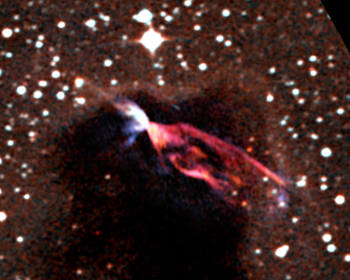Tuesday, August 20, 2013; 10 a.m. E.D.T.
Contact:
Charles Blue, Public Information Officer
Charlottesville, Virginia
(434) 296-0314
cblue@nrao.edu
Starbirth Surprisingly Energetic: ALMA observations give new insights into protostars

Full Caption |
While observing a newborn star, astronomers using the Atacama Large Millimeter/submillimeter Array (ALMA) telescope discovered twin jets of matter blasting out into space at record-breaking speed. These surprisingly forceful molecular "winds" could help refine our understanding of how stars impact their cloudy nurseries and shape their emerging stellar systems.
During their formative years, stars both take in and blast away tremendous amounts of matter. When this ejected material collides with the surrounding gas it glows, forming what is known as a Herbig-Haro (HH) object. This give-and-take can greatly impact the way a stellar system evolves and also reshape the surrounding nebula of dust and gas from which either single or whole families of stars form.
By studying one such stellar neighborhood, dubbed HH 46/47, the international team of astronomers uncovered high-velocity streams of carbon monoxide (CO) molecules flowing away from a star buried deep within its cloudy stellar nursery.
ALMA's superb sensitivity and the orientation of the star enabled the researchers to detect two jets of CO, when only one had ever been seen before. The data also revealed that this material was rushing along at 40 kilometers per second, which is 3 to 4 times faster than seen in previous CO observations.
"The ALMA data reveal molecular gas close to the protostar at velocities much higher that ever observed from such an object," said Héctor Arce from Yale University, the principal investigator on this study. "This means that this rapidly fleeing gas carries much more energy and momentum than previously thought, which could significantly impact the evolution of this emerging stellar system."
The star, which is located 1,400 light-years away in the constellation Vela, is relatively young -- on the order of a few hundred thousand years. The astronomers speculate that it is not significantly different from what our infant Sun would have looked like, though a little less massive.
In their youth, stars bulk-up by drawing in material from a surrounding disk of dust and gas. A portion of this material, however, gets diverted and caught-up in the star's magnetic fields causing it to be spewed out as jets from the stars' north and south poles.
Since there is a direct relationship between the jets and a star's accretion disk, there is a great deal to be learned about stellar formation by simply studying the jets.
ALMA discovered the high-velocity outflowing gas hidden within very wide-angle winds. The data also revealed that the surrounding cloud material was being pushed and accelerated by the winds. Since this is a normal, not very special protostar, the astronomers believe that the same features can be found elsewhere. If so, Arce speculates, astronomers would have to change their view on how much impact these outflows have. "If it has lots of energy, it can clear surrounding gas, leaving just the star and its surrounding disk of planet-forming dust and gas," said Arce.
These new observations also suggest that there have been episodes of outflow followed by quieter, less active periods. This would mean that there has also been episodic accretion of material onto the star.
Diego Mardones, a co-author on the study with the University of Chile, emphasizes that "this system is similar to most isolated low mass stars during their formation and birth. But it is also unusual because the outflow impacts the cloud directly on one side of the young star and escapes out of the cloud on the other. This makes it an excellent system for studying the impact of the stellar winds on the parent cloud from which the young star formed."
"The detail in the Herbig-Haro 46/47 images is stunning. Perhaps more stunning is the fact that, for these types of observations, we really are still in the early days. In the future, ALMA will provide even better images than this in a fraction of the time," adds Stuartt Corder with the National Radio Astronomy Observatory (NRAO), a co-author on the new paper.
The results are published in the Astrophysical Journal.
The National Radio Astronomy Observatory is a facility of the National Science Foundation, operated under cooperative agreement by Associated Universities, Inc.
ALMA, an international astronomy facility, is a partnership of Europe, North America and East Asia in cooperation with the Republic of Chile. ALMA construction and operations are led on behalf of Europe by ESO, on behalf of North America by the National Radio Astronomy Observatory (NRAO), and on behalf of East Asia by the National Astronomical Observatory of Japan (NAOJ). The Joint ALMA Observatory (JAO) provides the unified leadership and management of the construction, commissioning and operation of ALMA.
###
The paper is available at: http://arxiv.org/pdf/1304.0674v3.pdf